Technological Windows of Opportunity for Russian Arctic Regions: Modeling and Exploitation Prospects
Abstract
:1. Introduction
2. Materials and Methods
- A is a production function parameter,
- K is capital costs,
- L is labor costs,
- Y is the share of Arctic GRP in the GRP of the Russian Federation, %,
- α and β are parameters of the production function.
3. Results
3.1. Descriptive Analysis of the Technological Level of the Russian Arctic Zone
3.2. Cross-Correlation Functions of the Development of the Technological Level in the Russian Arctic Zone
3.3. Modeling the Production Function of Technological Windows of Opportunity for the Russian Arctic Zone
4. Conclusions
- There is considerable variability in the contribution of science-intensive and high-tech industries to the formation of gross value added in the Arctic region. At the same time, there is a stable dynamic of the contribution of the Arctic economy to the formation of the GRP of Russia as a whole.
- There is a steady growth of the productivity index over the average Russian indicators, which can be considered as the potential for growth of high-tech components of labor in the development of the economy of the Arctic zone.
- A negative statistically significant relationship has been identified between the share of the gross regional product of the Arctic in the Russian GRP and the share of GVA-intensive products in the Arctic GRP, which may be regarded as a factor preventing the use of opportunities of the emerging technological windows.
- Building a model of production function of technological windows of opportunities for the Russian Arctic zone pointed to the presence of potential in the exploitation of emerging technological windows of opportunity in the Russian Arctic zone in the development of human capital by activating and using high labor productivity, and creating high-performance jobs.
- -
- Inclusion of cross-indicators into the program of socio-economic development of the Arctic zone of the Russian Federation, allowing to assess and analyze the dynamics of the relation between indicators of material and human capital development.
- -
- Development of regional and industry sub-programs and projects of development of the region’s human capital as a key driver of technological development.
- -
- Development of basic projects to expand the range of high-tech production facilities of the existing technological order for the Arctic regions, implemented based on the principles of public–private partnership.
- -
- Implementation of industrial and social infrastructure projects aimed at achieving balance of interests in the development of material and human capital in the region.
Author Contributions
Funding
Institutional Review Board Statement
Informed Consent Statement
Data Availability Statement
Conflicts of Interest
References
- Alkire, Matthew B., Robert Rember, and Igor Polyakov. 2021. Discrepancy in the Identification of the Atlantic/Pacific Front in the Central Arctic Ocean: NO Versus Nutrient Relationships. Geophysical Research Letters 46: 3843–52. [Google Scholar] [CrossRef]
- Amon, Rainer M. W. 2021. The role of dissolved organic matter for the organic carbon cycle in the Arctic Ocean. Organic Carbon Cycle in the Arctic Ocean 12: 83–99. [Google Scholar]
- Bas, Tomas Gabriel, and Carolina Alejandra Oliu. 2018. Innovation strategy management survey of the Chilean biomedical industry. Assessment of windows of opportunities to reduce technological gaps. International Journal of Health Planning And Management 33: 512–30. [Google Scholar] [CrossRef]
- Cook, David, and Brynhildur Davidsdottir. 2021. An appraisal of interlinkages between macro-economic indicators of economic well-being and the Sustainable Development Goals. Ecological Economics 184: 106996. [Google Scholar] [CrossRef]
- Csapó, Hedvig Kriszta, Michał Grabowski, and Jan Marcin Węsławski. 2021. Coming home–Boreal ecosystem claims Atlantic sector of the Arctic. Science of the Total Environment 771: 144817. [Google Scholar] [CrossRef] [PubMed]
- Czerniawska, Jolanta, and Jiri Chlachula. 2020. Climate-change induced permafrost degradation in Yakutia, East Siberia. Arctic 73: 509–28. [Google Scholar] [CrossRef]
- Dai, Yixin, Stine Haakonsson, and Lars Oehler. 2020. Catching up through green windows of opportunity in an era of technological transformation: Empirical evidence from the Chinese wind energy sector. Industrial And Corporate Change 29: 1277–96. [Google Scholar] [CrossRef]
- Davenport, Jon M., LeeAnn Fishback, and Blake R. Hossack. 2020. Effects of experimental warming and nutrient enrichment on wetland communities at the Arctic’s edge. Hydrobiologia 847: 3677–90. [Google Scholar] [CrossRef]
- Durner, Georgy M., David C. Douglas, Ryan M. Nielson, Steven C. Amstrup, Trent L. McDonald, Ian Stirling, Metter Mauritzen, Erik W. Born, Øystein Wiig, Eric DeWeaver, and et al. 2009. Predicting 21st-century polar bear habitat distribution from global climate models. Ecological Monographs 79: 25–58. [Google Scholar] [CrossRef]
- Dyrdonova, Alena N. 2016. Methodological approach to evaluation of clustering potential and efficiency improvement management for development of the regional industry clusters. International Journal of Economics and Financial Issues 6: 243–48. [Google Scholar]
- Fahed, Ziad, and Anna Maria Daou. 2021. Interreligious Dialogue as a Gateway to the Sustainable Development Goals: A Lebanese Case Study. Journal of Ecumenical Studies 56: 24–54. [Google Scholar] [CrossRef]
- Government Programs Portal. 2021. Socio-Economic Development of the Arctic Zone of the Russian Federation. Available online: https://programs.gov.ru/Portal/program/43/passport (accessed on 23 May 2021).
- Grandmont, Katerine, Jeffrey Alan Cardille, Daniel Fortier, and Tania Gibryen. 2012. Assessing land suitability for residential development in permafrost regions: A multi-criteria approach to land-use planning in northern Quebec, Canada. Journal of Environmental Assessment Policy and Management 14: 1250003. [Google Scholar] [CrossRef]
- Klimenko, Tatyana I., Alexey I. Shinkevich, Svetlana S. Kudryavtseva, Marina V. Shinkevich, Naira V. Barsegyan, Angelika A. Farrakhova, and Izida I. Ishmuradova. 2018. Modeling factors of environmental tourism development in innovation economy. Ekoloji 27: 263–69. [Google Scholar]
- Klochko, Elena, and Olga Brizhak. 2019. Prospects of using virtual technologies in modern corporate business system. Advances in Intelligent Systems and Computing 726: 308–19. [Google Scholar]
- Koch, Viviane, Leana Zoller, Joanne M. Bennett, and Tiffany M. Knight. 2020. Pollinator dependence but no pollen limitation for eight plants occurring north of the Arctic Circle. Ecology and Evolution 10: 13664–72. [Google Scholar] [CrossRef]
- Kudryavtseva, Svetlana, and Alexey Shinkevich. 2015. An institutional approach to intellectual capital in open innovation systems. Paper presented at the 3rd International Conference on Innovation Management and Corporate Sustainability, Prague, Czech Republic, May 21–22; pp. 142–50. [Google Scholar]
- Novoselova, Irina Yu, Ivan V. Petrov, and Andrey L. Novoselov. 2020. Arctic coal: Methodological issues of an integrated risk assessment. Ugol 8: 88–91. [Google Scholar] [CrossRef]
- Popović, Svetislav G., Milica Dobričić, and Sanja Vlahović Savić. 2021. Challenges of sustainable spatial development in the light of new international perspectives-The case of Montenegro. Land Use Policy 105: 105438. [Google Scholar] [CrossRef]
- Pullman, Erik R., M. Torre Jorgenson, and Yuri Shur. 2007. Thaw settlement in soils of the Arctic Coastal Plain, Alaska. Arctic, Antarctic, and Alpine Research 39: 468–76. [Google Scholar] [CrossRef] [Green Version]
- Rosstat. 2021. Arctic Zone of the Russian Federation. Available online: https://gks.ru/free_doc/new_site/region_stat/arc_zona.html (accessed on 23 May 2021).
- Samarina, Vera P., Tatyana P. Skufina, and Alexandr V. Samarin. 2018. Russia’s North Regions as Frontier Territories: Demographic Indicators and Management Features. European Research Studies Journal 21: 705–16. [Google Scholar] [CrossRef]
- Shebalin, Peter N., Clement Narteau, and Sergey V. Baranov. 2020. Earthquake productivity law. Geophysical Journal International 222: 1264–69. [Google Scholar] [CrossRef]
- Shelomentsev, Andrey G., Olga A. Kozlova, Tatyana V. Terentyeva, and Ye. B. Bedrina. 2014. Comparative estimates of Kamchatka territory development in the context of northern territories of foreign countries. Economy of Region 2: 89–103. [Google Scholar] [CrossRef]
- Shelomentsev, Andrey G., Olga A. Kozlova, Zhanna A. Mingaleva, Ye B. Bedrina, and Tatyana V. Terentyeva. 2015. Comparative analysis of regional development of Northern Territories. Asian Social Science 11: 349–56. [Google Scholar] [CrossRef]
- Shkarupeta, Elena, Diana Savon, Lyudmila Borisova, Andrey Safronov, and Galina Kruzhkova. 2020. The Methodology for Assessing Innovative Maturity. Paper presented at the 35rd International Business Information Management Association Conference, IBIMA 2020: Education Excellence and Innovation Management: A 2025 Vision to Sustain Economic Development during Global Challenges, Seville, Spain, April 1–4; pp. 10218–25. [Google Scholar]
- Skufina, Tatyana, Ekaterina Bazhutova, Vera Samarina, and Natalya Serova. 2019. Corporate Social Responsibility as a Reserve for the Growth of Entrepreneurial Activity in the Russian Arctic. Humanities & Social Sciences Reviews 7: 1024–31. [Google Scholar]
- Spinosa, Ludovico, and Puja Doshi. 2021. Re-thinking sludge management within the Sustainable Development Goal 6.2. Journal of Environmental Management 287: 2021. [Google Scholar] [CrossRef]
- Sustainable Development Goals. 2021. Available online: https://www.un.org/sustainabledevelopment/ru/sustainable-development-goals/ (accessed on 23 May 2021).
- Tambovceva, Tatjana, Maria Tereshina, and Vera Samarina. 2019. Green innovations in the regional economy. Paper presented at 18th International Scientific Conference Engineering for Rural Development, Jelgava, Latvia, May 22–24; vol. 18, pp. 1832–39. [Google Scholar]
- Tseng, Jack. 2021. Polar bear diet in the face of Arctic climate change. Global Change Biology 27: 3004–5. [Google Scholar] [CrossRef]
- Vertakova, Yulia, Yulia Polozhentseva, Maria Klevtsova, and Irina Ershova. 2017. Integrated assessment of socio-economic differentiation: Cross-country comparison. Paper presented at the 30th International Business Information Management Association Conference, IBIMA 2017–Vision 2020: Sustainable Economic Development, Innovation Management and Global Growth, Valencia, Spain, May 13–14; pp. 1834–43. [Google Scholar]
- Voronina, Elena. 2020. Development of the Arctic regions of the Russian Federation: Drivers of greening. E3S Web of Conferences 244: 10051. [Google Scholar] [CrossRef]
- You, Cheng, Michael Tjernström, and Abhay Devasthale. 2021. Eulerian and Lagrangian views of warm and moist air intrusions into summer Arctic. Atmospheric Research 256: 105586. [Google Scholar] [CrossRef]
- Zhou, Yuan, Zhongzhen Miao, and Frauke Urban. 2020. China’s leadership in the hydropower sector: Identifying green windows of opportunity for technological catch-up. Industrial And Corporate Change 29: 1319–43. [Google Scholar] [CrossRef]
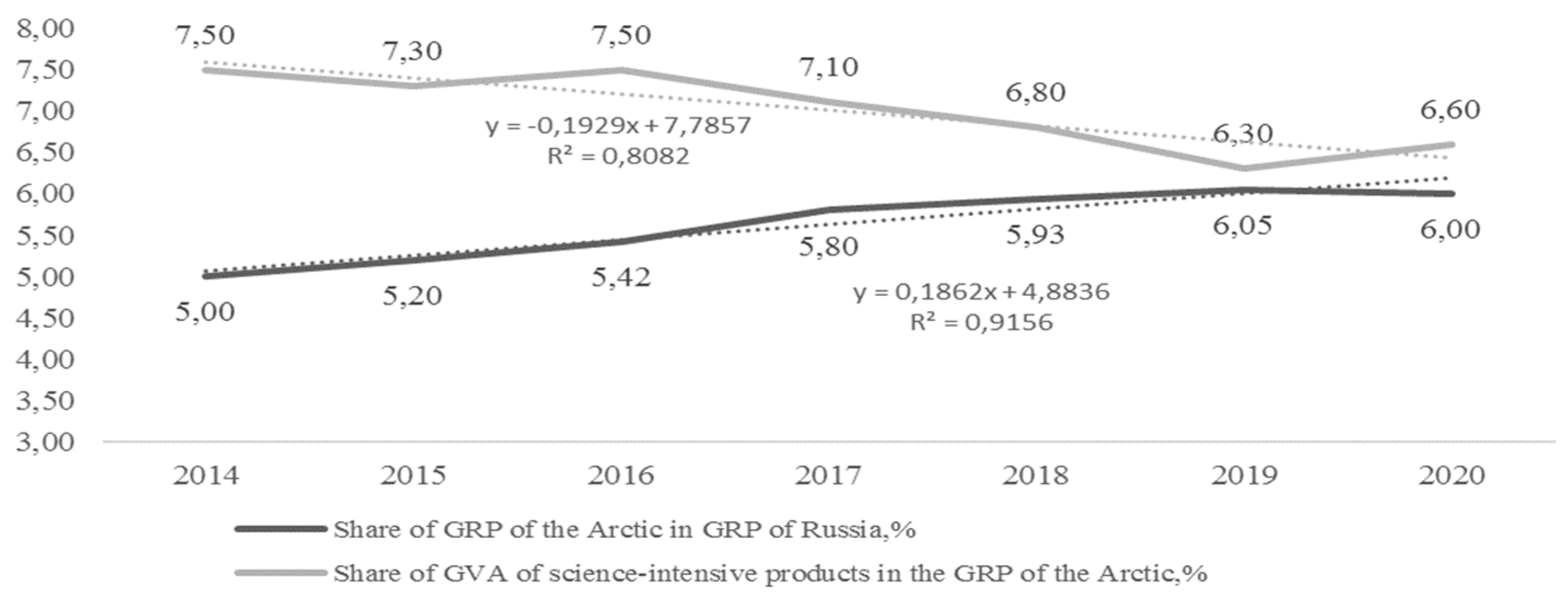
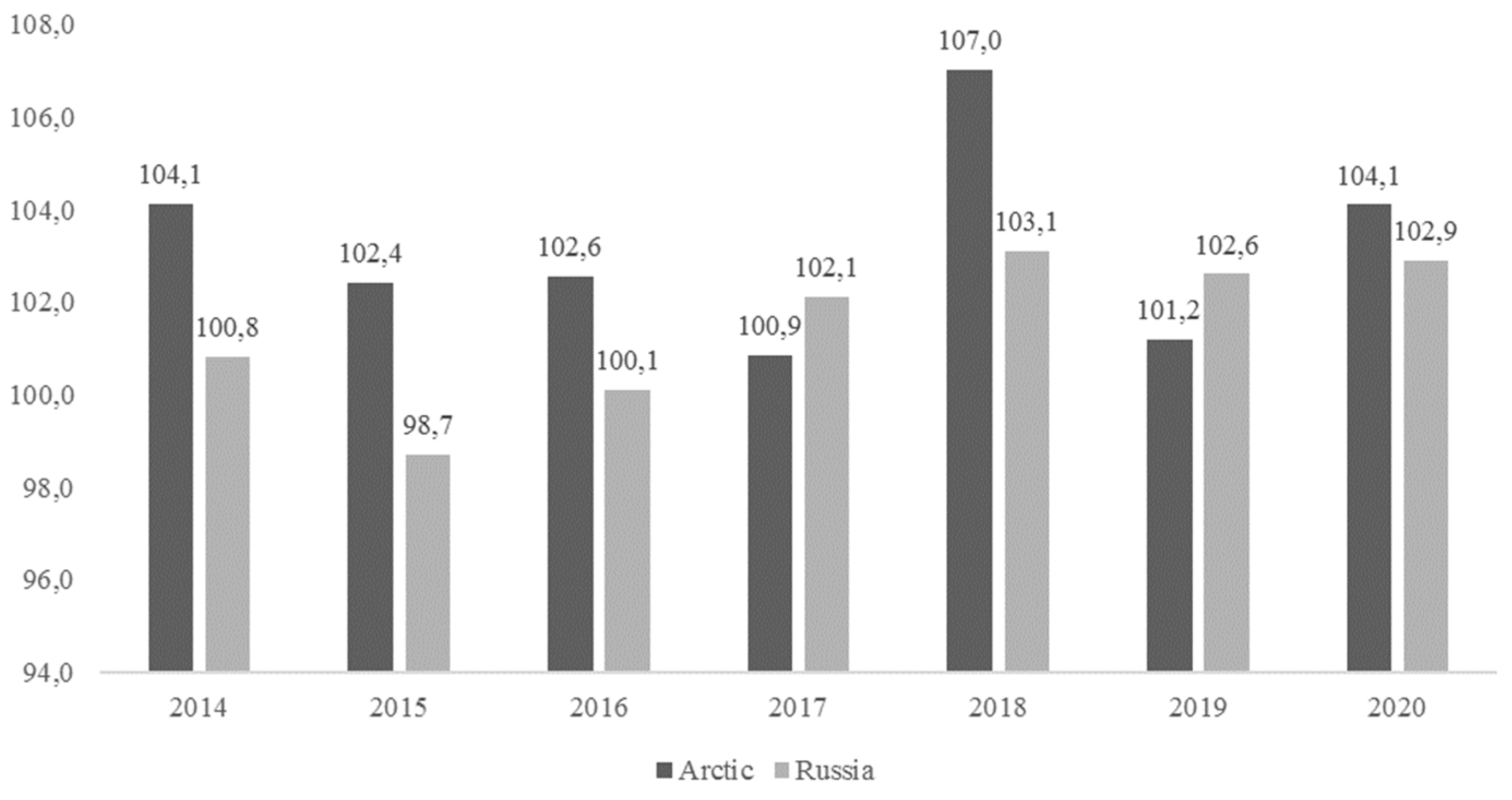
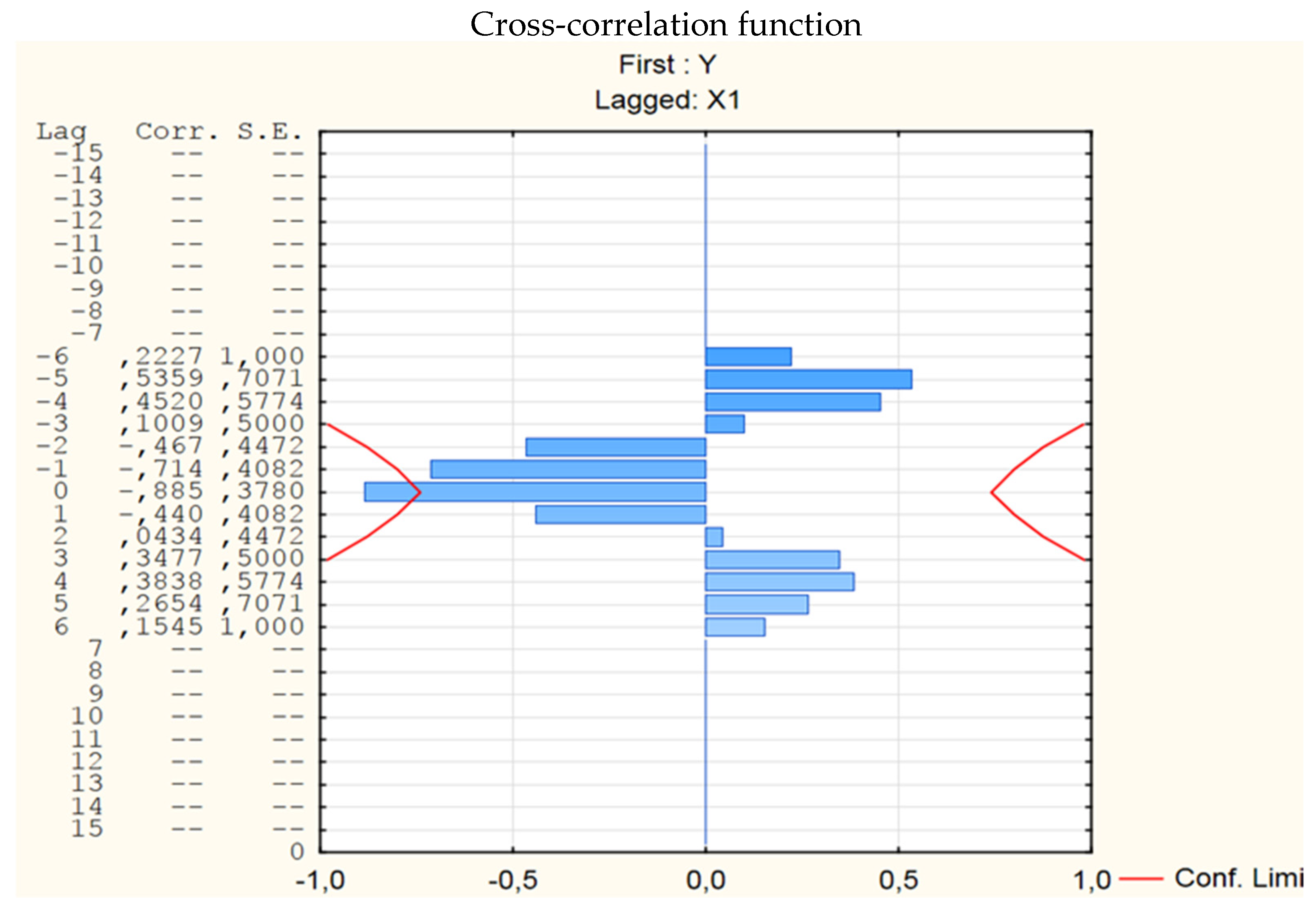
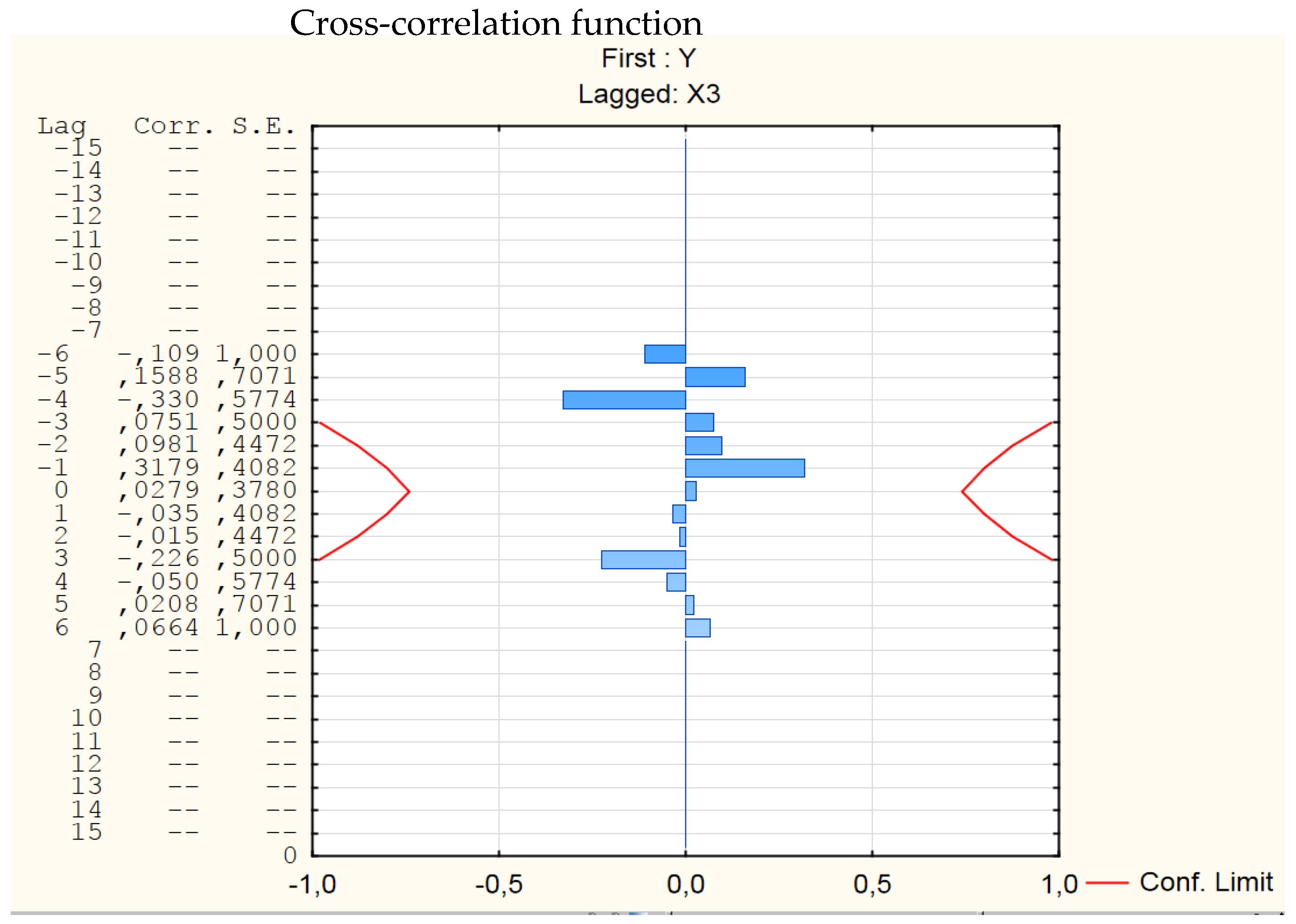
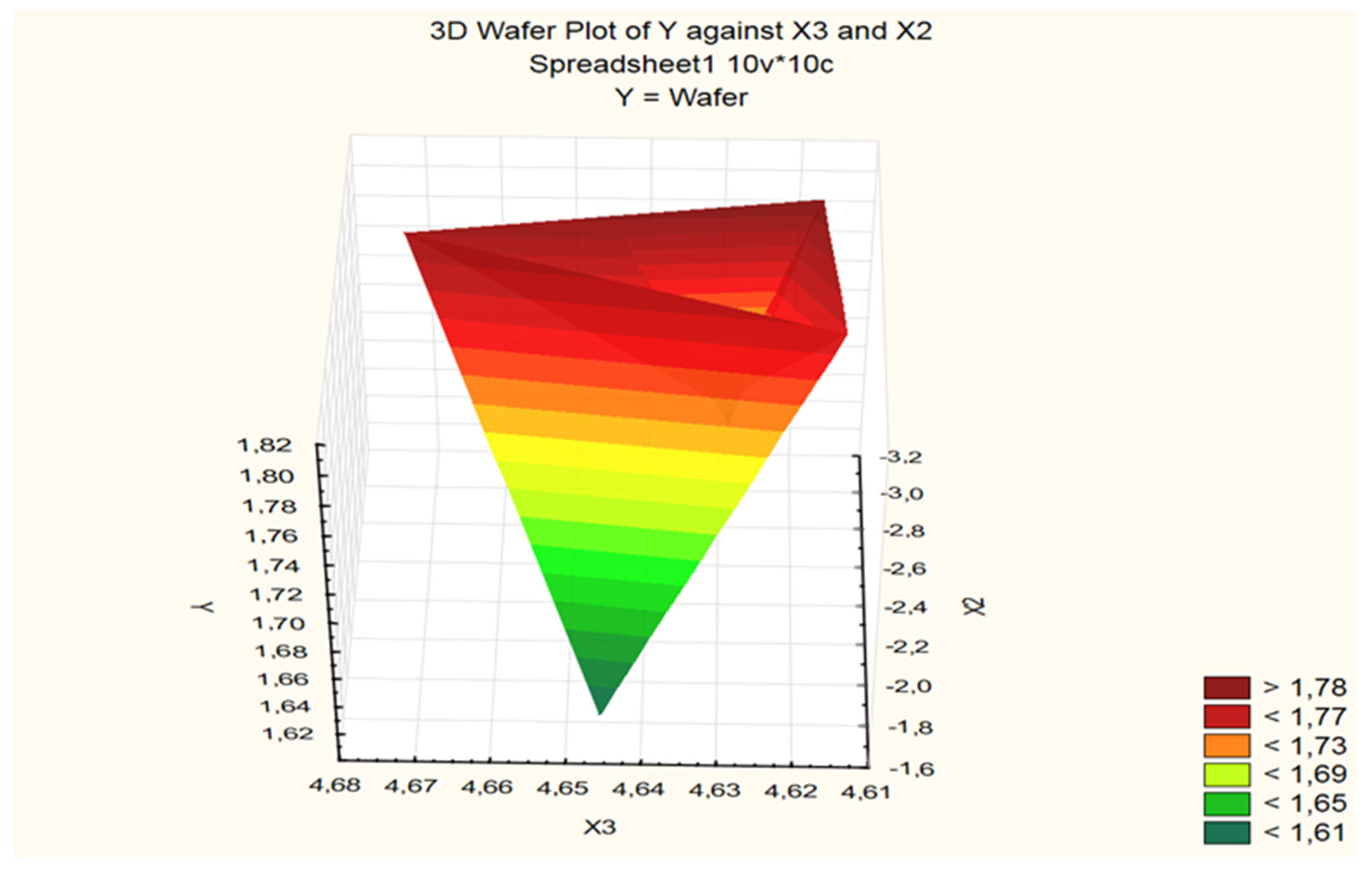
| Ind. | Mean | Median | Minimum | Maximum | Range | SD |
|---|---|---|---|---|---|---|
| Y | 5.63 | 5.80 | 5.00 | 6.05 | 1.05 | 0.42 |
| X1 | 7.01 | 7.10 | 6.30 | 7.50 | 1.20 | 0.46 |
| X2 | 0.07 | 0.05 | 0.05 | 0.17 | 0.12 | 0.04 |
| X3 | 103.18 | 102.55 | 100.85 | 107.00 | 6.15 | 2.11 |
Publisher’s Note: MDPI stays neutral with regard to jurisdictional claims in published maps and institutional affiliations. |
© 2021 by the authors. Licensee MDPI, Basel, Switzerland. This article is an open access article distributed under the terms and conditions of the Creative Commons Attribution (CC BY) license (https://creativecommons.org/licenses/by/4.0/).
Share and Cite
Samarina, V.P.; Skufina, T.P.; Savon, D.Y.; Kudryavtseva, S.S. Technological Windows of Opportunity for Russian Arctic Regions: Modeling and Exploitation Prospects. J. Risk Financial Manag. 2021, 14, 400. https://doi.org/10.3390/jrfm14090400
Samarina VP, Skufina TP, Savon DY, Kudryavtseva SS. Technological Windows of Opportunity for Russian Arctic Regions: Modeling and Exploitation Prospects. Journal of Risk and Financial Management. 2021; 14(9):400. https://doi.org/10.3390/jrfm14090400
Chicago/Turabian StyleSamarina, Vera P., Tatiana P. Skufina, Diana Yu. Savon, and Svetlana S. Kudryavtseva. 2021. "Technological Windows of Opportunity for Russian Arctic Regions: Modeling and Exploitation Prospects" Journal of Risk and Financial Management 14, no. 9: 400. https://doi.org/10.3390/jrfm14090400
APA StyleSamarina, V. P., Skufina, T. P., Savon, D. Y., & Kudryavtseva, S. S. (2021). Technological Windows of Opportunity for Russian Arctic Regions: Modeling and Exploitation Prospects. Journal of Risk and Financial Management, 14(9), 400. https://doi.org/10.3390/jrfm14090400






